Service-learning classes take students into community for immersive experiences
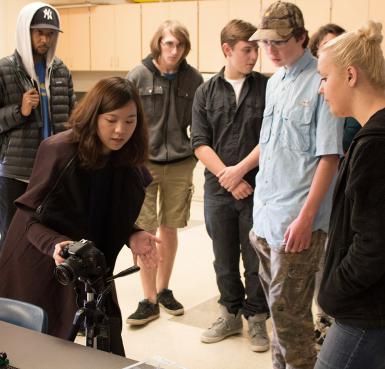
Working with community organizations and clients, Media School students are putting their classroom skills to work in a real-world environment: the classes themselves.
“This is what it’s going to be like when we are a year away in jobs, and this experience gives us an advantage going to work at an actual agency,” said Laura Swartz, a senior in J488 Agency Practicum, a class that requires students to manage their time to meet with clients, develop ideas and launch campaigns.
The class is one of several service-learning courses where students interact with organizations and people in the community to provide a service that taps into the skills they learn in class. Often, class time is for team meetings, problem solving and troubleshooting production issues, not lectures and quizzes.
“Textbooks are concrete, and service learning helps you put that in the real world, where you can see how factors influence what you have learned,” said Nicole Schönemann, director of service learning at IU’s Center for Innovative Teaching and Learning. Her department provides guidelines and support to instructors who want to make service learning part of their coursework.
Service learning helps students “understand the material in a more textured way, and then in a deeper way,” she added.
For students, getting off campus is a learning experience in itself and a way to feel connected to something larger than college life.
“It’s really valuable for students to get to know the community in which they live for four years,” Schönemann said. “It’s easy to be isolated on campus.”
For many IU students, service learning means serving a certain number of volunteer hours at a local nonprofit or other organization. But Media School students engage in project-based service learning, working directly with people on specific projects in which they share their classroom learning and expertise.
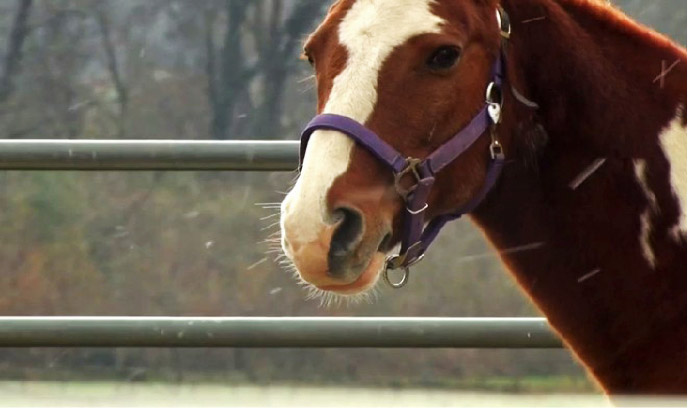
Faculty have different reasons for including a service-learning component in their courses, but they share a commitment to pushing students out in the Bloomington community.
“For university students, who are all about the same age, campus can become like a bubble,” said Sarah Neal-Estes, journalism visiting professor who teaches audio storytelling. Interviewing people not affiliated with IU, of differing ages and involved in non-campus activities, is not only great subject matter for projects, but allows students a chance to learn about the area beyond campus, she said.
Neal-Estes and associate professor Mike Conway each have received CITL’s Beth Wood Distinguished Service-Learning Faculty Award, an honor for faculty who have researched and developed courses that offer such experiences.
“Sarah’s and Mike’s projects involved community partners who were excited to be working on the projects,” Schönemann said. “There is a lot of communication between the instructor and the community partner, and, ultimately, they come up with this amazing product that they have worked on together.”
Other professors have been service-learning fellows, part of a learning community where members discuss research on community-based learning and assist other professors who are interested in developing their own courses. Lecturer Susanne Schwibs is a fellow this year, and Conway was one in 2007.
— By Haley Church, junior
Read about five service-learning classes:
- Associate professor Mike Conway’s J560 Video Storytelling
- Lecturer Jim Krause’s T376 Studio Production
- Visiting professor Sarah Neal-Estes’s J460 Radio Innovation
- Lecturer Susanne Schwibs’ C438 Experiments with the Film Camera
- Lecturer Craig Wood’s J488 Agency 7 Practicum
Classes connect students to the community
Haley Rios, senior, taught high school students about film For service learning, the class participated in teaching the high school students about film and editing.
Jade Sharp, senior, taught high school students about film It made me realize how much I didn’t know before going into college and how much I’ve learned, and it just really showed me how much I can share with younger kids.
Associate professor Mike Conway, J560 Video Storytelling Service learning, for me, is a class that gets students out into the community where they are interacting with people in the Bloomington area.
Lecturer Jim Krause, T376 Studio Production It gives students a real organization to work with. It raises the bar.
Lecturer Susanne Schwibs, C438 Experiments with the Film Camera My students teach the students there some experimental techniques.
I think it was helpful for the kids because I know a lot of them went into it not knowing how to make a film at all, and a lot of them didn’t know what a storyboard was, they had never seen a light kit before, so I think a lot of them just took away the basics of making a film.
It’s an immersive learning experience. I mean, we’re not just in the studio, we’re not just in the classroom. They have to go out and they actually have to interact with and see how the organization operates and they have to find out what the organization’s needs are.
They are going into the high school as sort of expert consultants. They have to be the teachers, and they have to be the experts.
Not only did it show me what I knew, but it gave me the experience of having to help somebody else learn something. I’ve never actually had to teach something that I’ve learned.
Jia Wei, junior, taught high school students about film It’s beneficial for both the students in the academy and for us.
Unless you push your comfort zone, you’re never going to learn anything new.
Get out of the campus environment and get to know people in the community and see people who are doing things for altruistic reasons. They’re not making money doing this volunteer work, they’re doing it because they care about it.
Daniel Morgan, senior, developed marketing plan It’s cool to join the Bloomington Winter Farmer’s Market and, you know, improve it and integrate the community.
And one of the things that makes Bloomington unique is the volunteerism, the spirit. Bloomington is a small enough city that you can get involved and make a real difference.
I think we should have more people do things like this.
Produced by Rachel Johansen, Jon Goethals, Bronson DeLeon
Music from Jamendo by Josh Woodward
J560 students focus on area volunteerism
By Haley Church
Associate professor Mike Conway has been teaching service-learning courses almost since he started as a journalism professor in 2004. His experiences as an undergraduate student at IU in the early 1980s inspired his interest, he said.
“When I was an undergrad, I didn’t know a lot about Bloomington because I was always on campus,” said the former TV reporter, producer and news director. “But when I came back after my TV career to live here, I just loved the community as a community, and the volunteerism is such a big part of what makes Bloomington cool.”
Students in Conway’s video storytelling class work with the city’s Bloomington Volunteer Network to produce four- to six-minute videos about Be More Award nominees. The public nominates candidates who have devoted their time and efforts to volunteering, and the BVN honors a few each year with Be More Awards.
“My students go through the nomination forms and see stories that they think would be interesting to tell,” Conway said. Students develop the ideas, then plan the execution of the video projects. “This accomplishes the goals of the class as well as well as brings attention to volunteerism.”
Students this semester had a variety of volunteer stories to share, ranging from a story about an affectionate horse to a profile of an exceptional woman filling a vital role in the Interfaith Winter Shelter.
Graduate student Will Healey said as with any in-depth project, there were challenges to getting his story about the woman at Interfaith. He had to manage his time as he collected photos and audio, arranging interviews and shoots around his own course schedule and work load.
“I went to a couple of different churches around town, and I went to the shelter and talked to the volunteers she had coordinated to be there,” he said. “That took a lot of time.”
Conway meets with Bet Savich, the director of the Bloomington Volunteer Network, before every semester to make sure the class is benefiting both parties. They have been in the partnership since Conway met Savich at a service-learning panel several years ago.
“I watch all of the videos,” she said. “The students bring their expertise and a fresh take to the story.”
Savich said without the students’ work, BVN would have no videos of the volunteers to show at the awards ceremony. The profiles of the volunteers inspire others to get involved in the community, she said.
T376 Studio Production provides public service announcements
By Anthony Broderick
Using equipment and facilities equivalent to those of professionals, students in T376 Studio Production are providing a professional service as well. As part of their semester work, they create and produce public service announcements and volunteer recruitment videos for area nonprofits.
At the beginning of the semester, lecturer Jim Krause introduces students to clients, whom they locate through the CITL service-learning program. The student teams learn about the clients’ needs, then spend much of the semester producing PSAs or volunteer recruitment videos. Clients have included Big Brothers Big Sisters, Monroe County Public Library and the local animal shelter, among others.
“When you give students a real organization to work with, it raises the bar,” Krause said, because students are accountable to someone other than a professor and their work means something besides a grade. “It’s an immersive learning experience.”
To get started, representatives from the nonprofits explain their needs and exchange ideas with students, who work as teams to conceive, develop and produce the final products. They organize themselves as television production crews, alternating roles as floor director in charge of the studio with four other students operating the cameras, or as producers, audio technicians and actors.
In addition to the service-learning projects, students have other assignments in the class, all designed to improve their storytelling and technical skills. By the time they are polishing their service-learning projects, they have had enough experience to deliver quality products.
Students present the projects to their clients near the end of the semester, and clients post the work on YouTube, their websites or other outlets.
“There’s a class critique process after the assignment is turned in, and that’s where we discuss what is effective and what could have been done better,” Krause said. “Some students have said they had the best experience of their life doing these public service announcements.”
J460 Radio Innovation students tell local elementary school’s story
By Haley Church
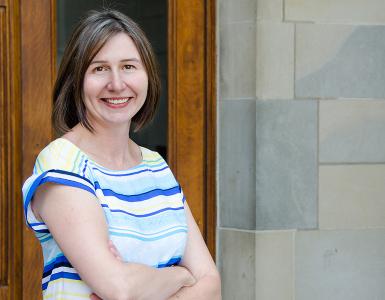
Teaching a service-learning class had not always been on visiting professor Sarah Neal-Estes’s agenda, but she discovered its significance after working with the program last year. Her J460 Radio Innovation students decided to report on the Templeton Elementary K-6 class, where all seven grades operate as one class. The students documented the way the Templeton class worked as well as taught the students reporting skills to share their own stories.
Journalism student Bari Finkel was one of the producers for the project, “How Do Stories Bring Us Together?”
“Being an IU student in Bloomington can be a bit of a bubble, so interacting with the community was beneficial for both the IU students and young kids,” she said. “By introducing them to audio storytelling, we opened doors of opportunity for the future that they may not have known.”
Partnership with Templeton Elementary School fit the criteria for an IU service-learning project, specifically by meeting the needs of a community partner while continuing to advance IU students’ education.
“Over the summer, a lot of people saw that project, and I knew I wanted to be involved in a similar way again this fall,” said Neal-Estes, a former public radio producer and reporter who also is advisor for the school’s American Student Radio project.
This semester, students covered organizations within the Advocates for Community Engagement organization, including New Leaf New Life, The Project School and Shalom Community Center.
For example, Shalom Community Center is erecting a statue to bring awareness to the issue of homelessness in the Bloomington community. Neal-Estes said the student profiling the center has been collecting interviews and natural sound.
Neal-Estes said she plans to continue building courses around service-learning projects such as this, most likely including some of the ACE organizations.
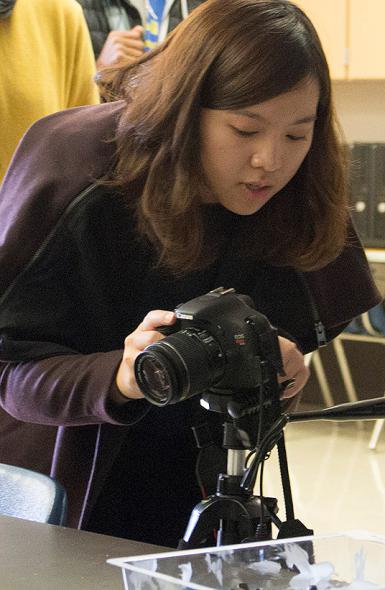
Film students teach high schoolers production skills
By Sam Robinson
Students in lecturer Susanne Schwibs’ C438 Experiments with the Film Camera learn that there’s more to film than cameras and footage. They experiment with film to learn two things: how to see the world through the lens of a camera and how to manipulate footage—by drawing on it, scratching it or marking on it—to tell a story.
But this semester, the students are the experiments.
For the first time, students are working with high school students at a Bloomington private school, Academy of Science and Entrepreneurship, to take their skills to a younger generation of filmmakers. The Media School students help the high school students find their passion as filmmakers – or at least be able to conduct a few rudimentary tasks.
And through it all, the IU students learn their craft by becoming the masters.
Junior Jia Wei found that she learned just as much as she taught.
“It feels like the students know a lot,” Wei said. “I’m also new, so it’s a great way to communicate with them.”
The high school students learn filmmaking from a historical perspective. They watch historical works and study why they are considered masterpieces.
Watching movies is one thing, but making them is an entirely different story. During one of their periodic meetings at the school, Jia Wei and senior Yue Yan taught students the methods in stop motion. The IU students found the high schoolers were not strangers to creative storytelling.
“We were talking about making horror movies, and the students suggested an idea,” Yan said. “I thought, ‘Huh, I never considered that.’”
The program was originally meant to teach the high school students stop motion exclusively. But the number of sessions during the semester ballooned to cover cinematography and lighting, 16mm film and time lapse.
Though Schwibs worked closely with colleagues at the academy to design the courses and the service-learning aspect, she doesn’t attend the during the high school instruction period because she doesn’t want to interfere with the students’ creative process.
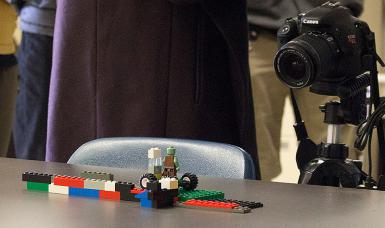
“I always think that when you teach something or when you try to explain something, you start to think about what you do a little differently,” said Schwibs, an Emmy Award-winning filmmaker and producer/director at IU Radio Television Services.
Schwibs said teaching media to younger students gets her students to think outside the box.
“So much of media is about communicating a message to someone, and you get wrapped up in your own ideas about that,” Schwibs said. “But there’s something about enabling someone else with engaging in a social function that is helpful.”
Some of the high school students may see their work presented at the IU Cinema along with the C438 students’ work at the Double Exposure film event in spring. Double Exposure features a live orchestra, and for each final project in C438, students at the Jacobs School of Music compose an original score.
J488 Agency Practicum provides full-service ad agency experience
By Haley Church

In lecturer Craig Wood’s J448 Agency Practicum class, students work with big name clients like Whirlpool and Maytag, and with local nonprofits such as the Bloomington Winter Farmers Market.
During the semester, the integrated marketing communication class operates as Agency 7, which produces advertising as well as public relations strategies to cater to clients’ needs. The class is for juniors and seniors exclusively, with permission from the instructor, Wood.
“It’s hands-on application, taking these skills and then actually applying them in the field,” said Wood, a former ad agency exec who has been teaching courses with service-learning aspects since he came to IU in 2007.
This is the second semester Wood’s class has worked with Bloomington Winter Farmers Market. Previous classes have worked with American Red Cross, the Boy Scouts of America, and the Boys and Girls Club.
The students working with the Bloomington Winter Farmers’ Market this semester are Laura Swartz, Dan Morgan, Dana Koglin and Hannah Imel.
“It all started with them coming to us knowing that they weren’t happy with attendance and awareness,” said Swartz of the team’s first meeting with leaders from the market. “They felt overshadowed by the summer farmers market.”
The students worked with the market’s board to design a campaign that includes ways of engaging consumers, such as flyers for events.
“I like that we are able to apply concepts and techniques we’ve learned to a real-world situation,” Morgan said. “We get feedback from a real client and not just a teacher or advisor. We even have some of the same frustrations that we’ll experience in the actual workplace.”
Students may take the Agency 7 class a second time with permission from Wood. Because the clients and, therefore, the projects, are different each semester, students will have new experiences, Wood said.

